Snoring mouth guards or anti-snoring mouth guards are a popular way of preventing snoring and sleep apnoea. You can find out how they work, which snoring mouth guard is the right choice for you, and the expected costs in our guide. In addition, position-related snoring problems can also be reduced by using special positioning aids such as anti-snoring pillows.
How does a snoring mouth guard work?
One very common cause of snoring is that the base of the tongue becomes limp during sleep and then slips backwards to constrict or close the throat area.
This is precisely where snoring mouth guards come in. They can take the form of either a single component or two combined plastic parts, and are worn on the teeth while sleeping.

The snoring mouth guard pushes the lower jaw forwards, and with it the base of the tongue. This keeps the base of the tongue away from the throat area.
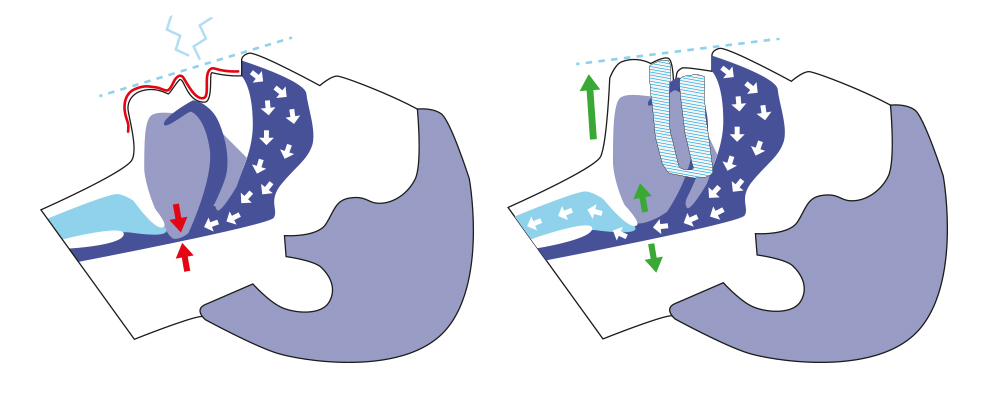
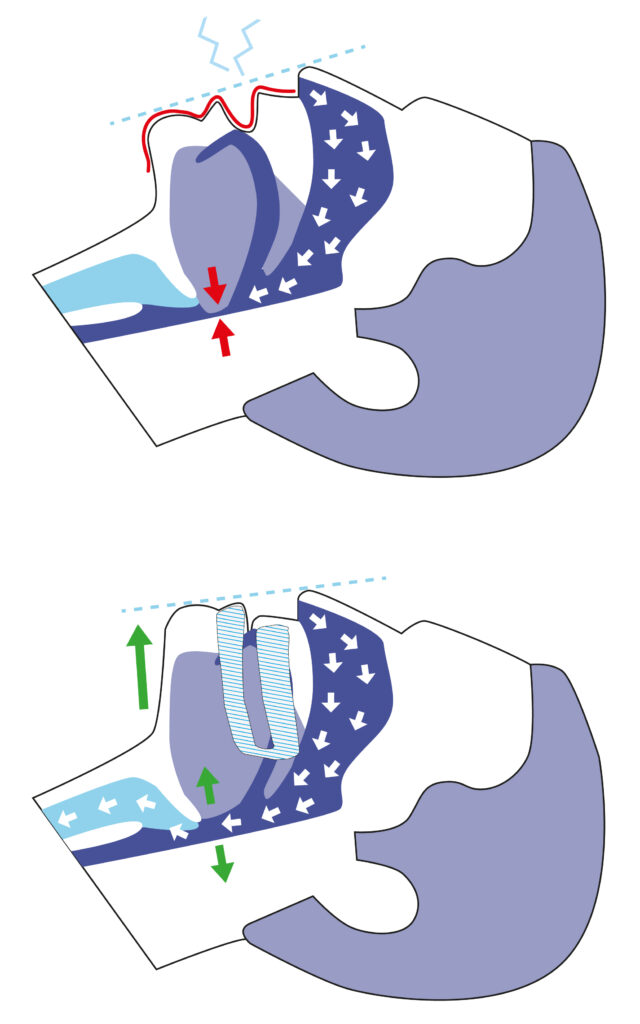
The best snoring mouth guards
These five snoring mouth guards are the most popular among our SomniShop customers:
somnipax guard standard
Extremely comfortable high-end guard for small and medium-sized jaws
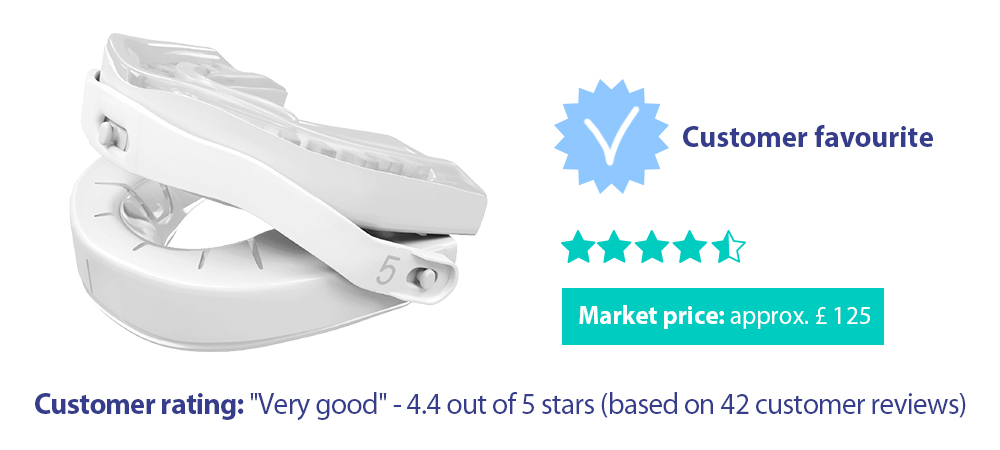
Here’s what SomniShop customers have to say about the somnipax guard standard:
+ An effective mouth guard that works perfectly (frequently measured by a snoring app or pulse oximeter)
+ Good alternative to CPAP machines for people with minor to moderate sleep apnoea
+ Comfortable guard, sits well in the mouth
+ The trial option (guard can be returned even after use for a surcharge) is great
– Replacement straps can only be bought as a set
What the professionals at SomniShop have to say about this snoring mouth guard:
Thanks to its flat design, the somnipax guard S is a very comfortable yet robust mouth guard. Good lateral movement due to the two-part design (important for the jaw joint), with 8 stages for precise adjustment. The high level of customer satisfaction speaks for itself. Please note: This mouth guard is too small for some people. You should therefore use the sizing information for the guard to check whether it will fit.
SomnoGuard AP2
Highly robust, tried-and-tested quality mouth guard for medium and large jaws
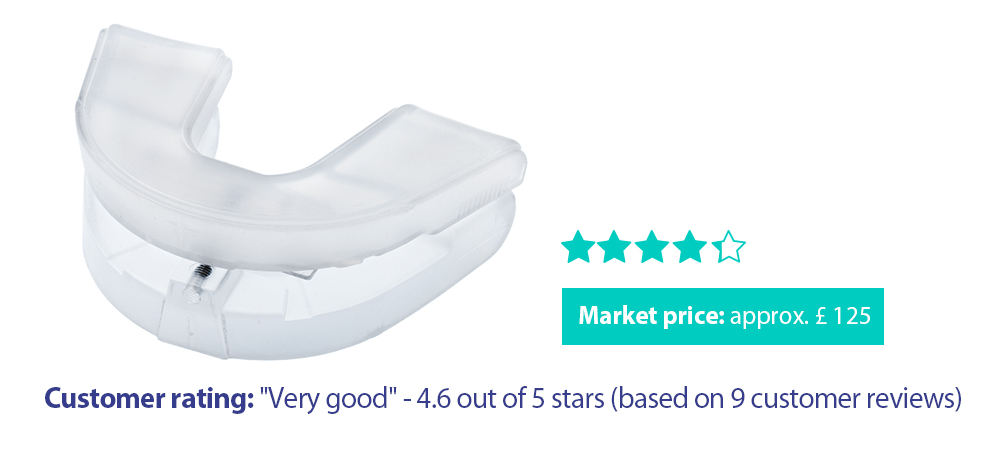
Here’s what SomniShop customers have to say about the SomnoGuard AP2:
+ Comfortable mouth guard that doesn’t particularly feel like having a foreign body in the mouth
+ Easy to clean
– Adjustment takes a bit of skill
– Not suitable for small jaws
What the professionals at SomniShop have to say about this snoring mouth guard:
Very sophisticated and exceptionally robust mouth guard, made in Germany. Suitable for medium to large jaws, very good lateral jaw joint movement. The mouth guard is very bulky due to its robust design, so it is not recommended for small jaws.
SomnoGuard 3
Individually adjustable divider to prevent simple snoring
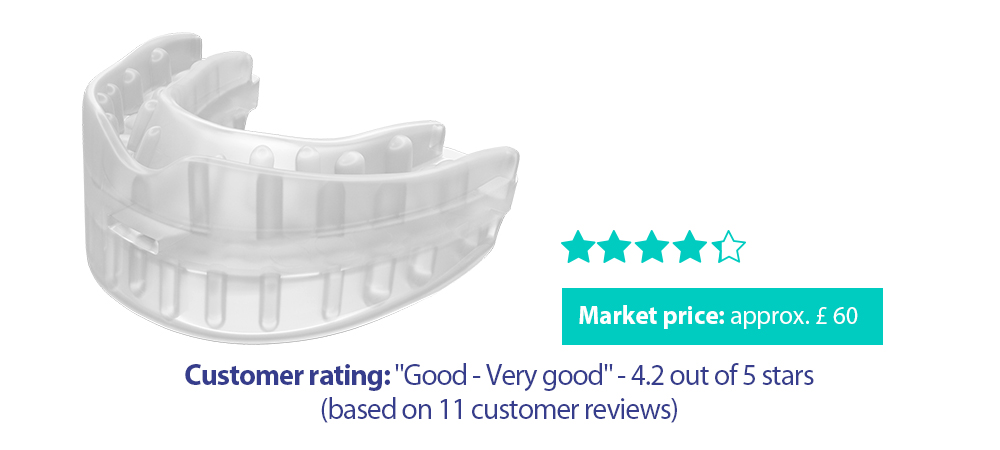
Here’s what SomniShop customers have to say about the SomnoGuard 3:
+ Immediately stops simple snoring
+ Affordable mouth guard with very good and professional instructions
– Needs to be well-adjusted, due to the single-component design, the thermoplastic material can only be applied to the teeth from the outside and not from the inside
What the professionals at SomniShop have to say about this snoring mouth guard:
A single-component mouth guard that has been on the market for many years, with retaining grooves for a particularly good fit. As with the SnorBan, no lateral jaw joint movement, but counteracts two causes of snoring simultaneously (tongue base snoring and snoring independent of body position as a result of mouth breathing).
What criteria need to be considered when choosing a snoring mouth guard?
There are three key factors that need to be taken into account when choosing a snoring mouth guard: The size, the comfort and the protrusion adjustment.
Selecting the right size
By far the most important factor is the size. With tailor-made snoring mouth guards from a dentist, ensuring the right size isn’t a problem. But the significantly cheaper mass-produced mouth guards tend to be “one-size-fits-all”. The actual size may vary from mouth guard to mouth guard (like with clothing, where the same size, e.g. ‘Small’ is often different depending on the manufacturer).
We therefore recommend using a clean piece of cardboard to compare the size of your jaw with the size of the mouth guard before making a purchase. There are three steps to this process:


Step 1: Cut out a square of clean, thick cardboard. This should be big enough that you can fit it in your mouth and bite down onto it. Some customers have used a Camembert instead of a piece of cardboard; this works too.
Step 2: Put the piece of cardboard in your mouth and bite down onto it. You should then be able to see the impression of your jaw on the cardboard. If not: Repeat the process and bite down more firmly.
Step 3: Place the piece of cardboard on a table and take hold of a ruler. Now measure the width of the impression at the back teeth, from the outer left-hand side to the outer right-hand side.
Step 4: Compare the measurement with the sizing information relating to the width of the particular snoring mouth guard. The width of the impression should be at least one millimetre larger than the specified width of the mouth guard.
This means that the mouth guard is very likely to fit.
Comfort
Two-component snoring mouth guards that consist of one part for the upper jaw and one part for the lower jaw tend to be a lot more comfortable. This type of mouth guard also allows for lateral movement of the jaw. With single-component mouth guards, this isn’t usually possible as the upper and lower jaw are enclosed in a single, immovable part.
Less bulky materials also contribute to a more comfortable fit. The thinner and flatter the mouth guard, the more comfortable it tends to be (and therefore the more pleasant it is to use). To prevent teeth grinding, however, we nevertheless recommend robust and bulkier mouth guards such as the SomnoGuard AP 2. In this case, the mouth guards need to withstand particularly high stresses.
Protrusion adjustment
Precise protrusion adjustment is important for the effectiveness and comfort of a snoring mouth guard. In this area too, two-component snoring mouth guards are preferable to single-component guards.
With single-component snoring mouth guards, the protrusion is set by stretching the lower jaw forwards to a greater or lesser extent during the adjustment process. This is generally an imprecise method, and the entire adjustment process has to be repeated in order to change the protrusion.
The process is different with two-component snoring mouth guards. With these models, the protrusion is only set in a second step once the mouth guard has already been adjusted. It can be changed without having to re-adjust the mouth guard. This is particularly important when first starting to use the mouth guard: To begin with, you’ll need to keep changing the protrusion in order to find the right setting.
For quick guidance, take a look at our test-winning snoring mouthpiece article, which compares the currently top-rated snoring mouthpieces.
How effective are snoring mouth guards in general?
Mandibular advancement devices are an effective tool against situation-dependent snoring and position-dependent minor and moderate sleep apnoea. This is recognised in multiple medical guidelines such as those published by the American Academy of Sleep Medicine and the National Institute for Health and Care Excellence. These guidelines recommend the use of a snoring mouth guard if CPAP therapy does not guarantee success or is rejected by the patient (referred to as second-line treatment). As part of a very complex meta analysis, the German independent Institute for Quality and Efficiency in Health Care found that snoring mouth guards are not inferior to CPAP therapy in the treatment of sleep apnoea.
Practical information:
When it comes to snoring mouth guards, there is often a lack of differentiation between sleep apnoea or snoring that takes place in any position or that predominantly takes place when sleeping on the back (i.e. position-dependent). If the sleep apnoea or snoring is not position-dependent, the use of snoring mouth guards is considerably less likely to be successful. Snoring mouth guards push the limp base of the tongue forwards, as this limp tongue base is the typical cause of position-dependent snoring or sleep apnoea. If the snoring or sleep apnoea is not position-dependent, however, it will have a different cause: namely a vibrating soft palate or a collapsing trachea.
How to get a snoring mouth guard?
There are various ways to get hold of a snoring mouth guard. Customised mouth guards are sold by dentists, who work closely with dental laboratories.
Off-the-shelf mouth guards, on the other hand, are predominantly sold by specialist online providers.
The cost of snoring mouth guards
When it comes to costs, it’s important to distinguish between two types of mouth guards: customised mouth guards produced by dentists, and off-the-shelf mouth guards. Customised mouth guards cost between £1200 and £1500 depending on the system used and the costs charged by the particular dentist.
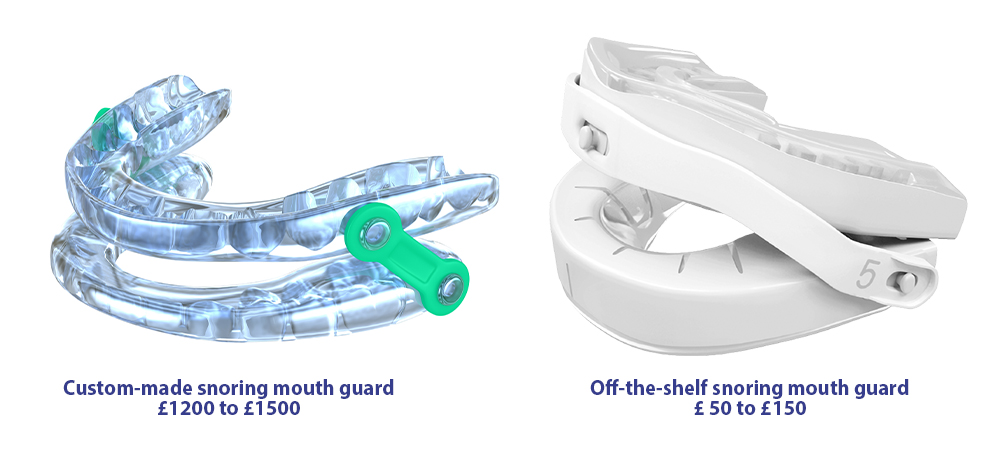
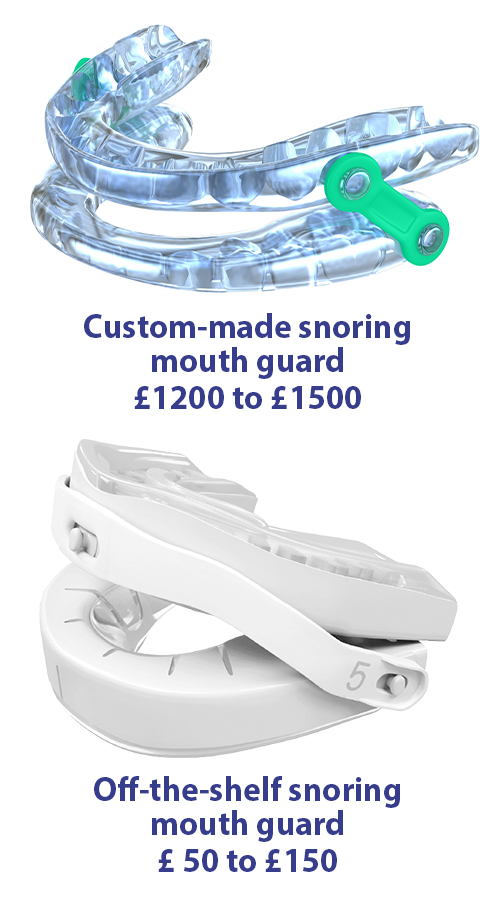
Off-the-shelf mouth guards, on the other hand, are much cheaper as they are mass-produced. They usually cost between £50 and £150. Sleep apnoea patients should be aware that the snoring mouth guard is actually CE-certified as a medical device This is generally not the case with extremely cheap snoring mouth guards, which tend to be single-component guards that are often made in China.
When a snoring mouth guard should not be used
A sufficiently good tooth condition is very important for using a snoring mouth guard. There are two practical key rules in this regard:
- There should be ten healthy teeth in both the upper and lower jaws (i.e. a total of at least twenty healthy teeth).
- The teeth should be distributed in the mouth as follows: Five healthy teeth in both the left and right side of the upper jaw, as well as an additional five healthy teeth in both the left and right side of the lower jaw.
Snoring mouth guards can also be used in the presence of securely anchored bridges, partial crowns or full crowns. If these are in an unstable or poor condition, the attending dentist should be consulted before using the snoring mouth guard.
Securely anchored prostheses or implants do not preclude the use of a snoring mouth guard (although this is not the case if they slack or loose).

The attending dentist should always be consulted before using a snoring mouth guard if the user
- has loose teeth or unhealthy upper and lower front teeth
- suffers from jaw pain, serious gum or jaw joint disease or other jaw complaints
- wears braces, bite splints or aligners
- has chronic asthma or epilepsy
What are the side effects of a snoring mouth guard?
Snoring mouth guards can have side effects such as tooth sensitivity, pronounced salivation or a change in the position of the teeth. Most side effects, however, are only temporary or are easy to fix.
Side effects of a snoring mouth guard | How can they be fixed? |
| Sensitive teeth in the morning | Press the jaw together three to four times after getting up; tooth sensitivity will usually disappear after this |
| The jaw feels tense. | Move the teeth back to their “normal state” by:
|
| Pain at the base of the ears | This is a common side effect at the beginning, but generally disappears again quickly. It can help to reduce the protrusion to start with and then increase it gradually. Exercises that move the teeth back to their “normal state” can also help with this issue (see “The jaw feels tense”). |
| Pronounced salivation | This issue usually subsides after a few days of regular use. |
| Teeth in the upper jaw interlocking with teeth in the lower jaw | Exercises that move the teeth back to their “normal state” can help with this issue (see “The jaw feels tense”). |
* Please note: Customer reviews collected mid-March 2023 from the German shop www.somnishop.com.
Mandibular advancement device guide – answers based on practical experience
Mandibular advancement devices can help with sleep apnoea in a lot of cases. They are now also provided by the NHS. Find out how exactly they can help, and when they are provided by the NHS.
Mandibular advancement device comparison
All our mandibular advancement devices compared based on comfort, application, cleaning and much more.

Dr. Daniel Grätz is the Managing Director of health.On Ventures GmbH, one of Germany’s leading online providers of snoring mouth guards, and has been providing customers with advice about these devices for many years.


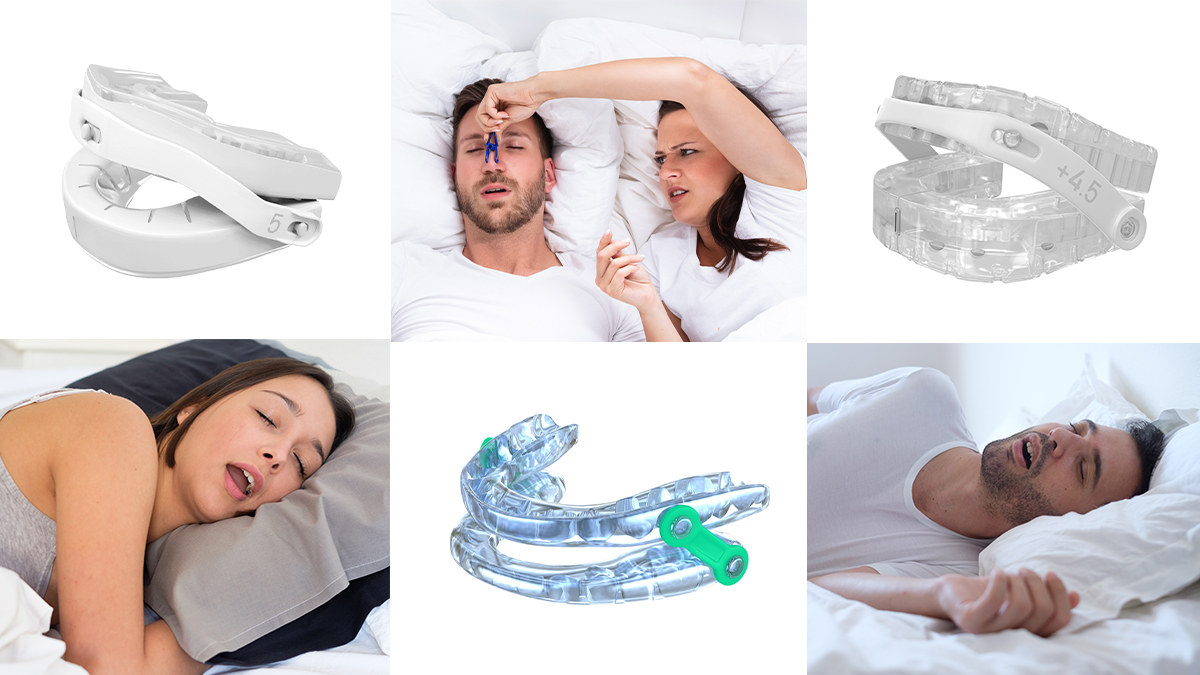
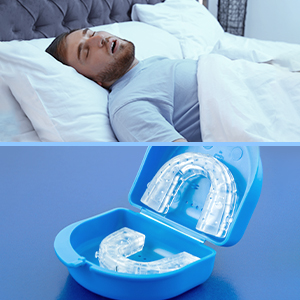
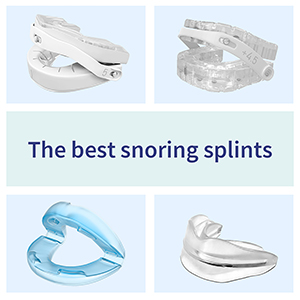
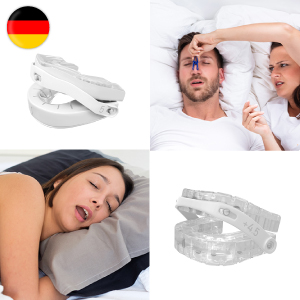
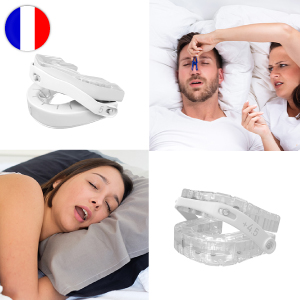
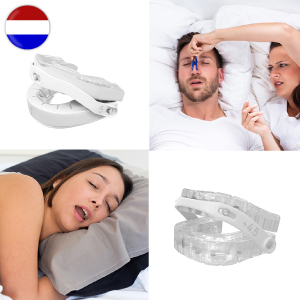


 Welcome to SomniShop
Welcome to SomniShop